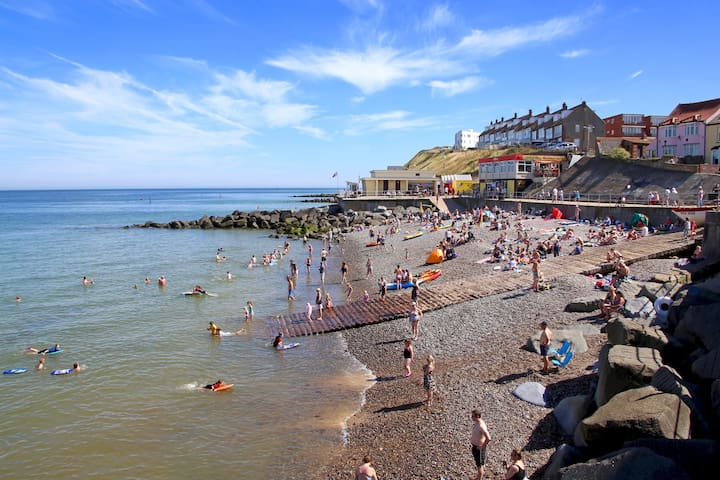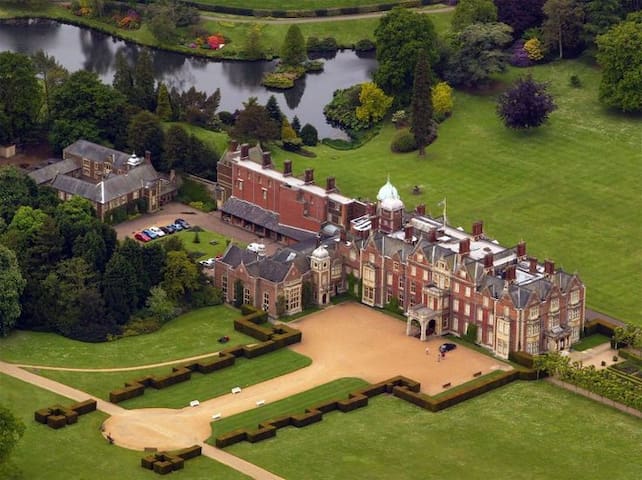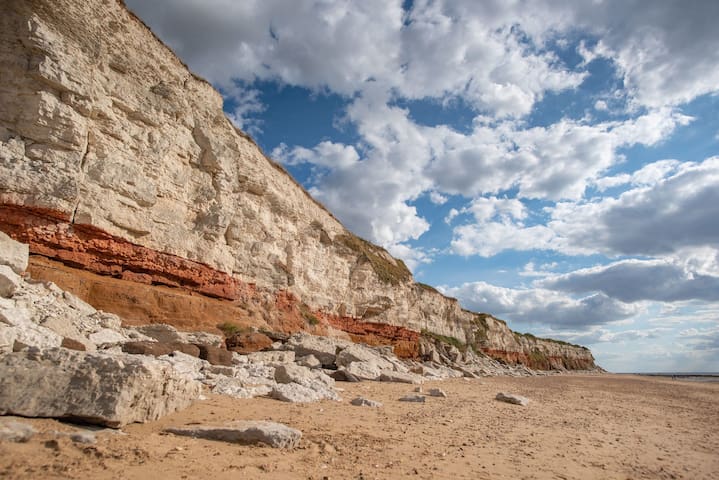City/town information
The name Wells comes from Guella, half Latinised from Anglian Wella, a spring. This derives from spring wells of which Wells used to have many, rising through the chalk of the area. The town started to be known as Wells-next-the-Sea in the early 19th century to distinguish it from other places of the same name. When the Wells and Fakenham Railway was opened on 1 December 1857, the terminus was given the name of "Wells-on-Sea". In 1956 the Wells Urban District Council voted to re-adopt the name Wells-next-the- Sea, and this has been the official name since then.
Wells is situated on the North Norfolk coast which runs for some thirty miles from Hunstanton to Cromer.
The North Sea is now a mile from the town, as a result of the silting of the harbour. The town has long thrived as a seaport and is now also a popular seaside resort with a popular beach that can be reached on foot or by a narrow gauge railway that runs partway alongside the mile-long sea wall north of the harbour.
The Quay in Wells is the hub of activity during the summer months, especially at weekends. People come to walk head to the beach, to fish for crabs on the Quay (called gillying), sample locally caught fresh shell fish and, of course, partake of good old local fish and chips! You can also buy Samphire which is found growing on the marshes locally.
If you want to see the quieter side of Wells, head off through some of the back streets and you will find plenty of pretty traditional cottages and gardens or wander up Staithe Street which has a wealth of shops, both traditional and modern.
Beaches:
Wells and Holkham Beaches
To get to Wells beach you can either walk along the sea path, take the railway to the Caravan Park or drive and park in the carpark.
Beware as in the summer the car park can be very busy indeed and you may have to queue. Wells beach is famous for its gaily painted beach huts and sand dunes. Some beach huts can be rented by the day. The beach is backed by dense pine woods which are part of the
Holkham National Nature Reserve. The woods comprise Scots pine, Maritime pine and Corsican Pine growing on sand. More pinewoods exist to the east of the beach over the shipping channel at an area called the East Hills. This can be accessed on
foot at low tide though all of the tidal sands in the arestarts to coma are extremely dangerous due to the speed and currents of the rising tide. It is not advisable to cross the channel without detailed local knowledge.
The sea is very shallow and swimming is only really possible at high tide. However, since the channel was built for the boats to supply the building of the new off-shore wind farm, there is a new channel which you can use for swimming. Do take care when the tide is coming in.
Wells has its own lifeboat station on the beach and has both an all- weather lifeboat and an inshore rescue boat. The old lifeboat house, now used as the harbour offices, is at the western end of the quay. In 1880, Wells was the scene of a lifeboat disaster in which 11 of the 13 lifeboat crew drowned, leaving 10 widows and 27 children without fathers. A memorial to the crew stands adjacent to the old lifeboat house.
Visitors are welcome to look around the lifeboat house on the beach and there are open days and displays at various times of the year.
Further to the west you will find Holkham beach and, of course, Holkham Hall, home to the Earl of Leicester. You can park in Queen Anne’s Drive which leads up to the beach (it’s paying). Holkham Bay is a stunning flat expanse of sand which gives you quite a walk to the sea when the tide is out. It’s great for kite flying, exploring the sand dunes, horse riding or just taking in those big Norfolk skies.
Other great beaches with acres of space: Brancaster (has a car park by the beach), Burnham Overy Staithe Beach (about a 1.5 mile walk) but worth it.
219 locals recommend
Wells-next-the-Sea
The name Wells comes from Guella, half Latinised from Anglian Wella, a spring. This derives from spring wells of which Wells used to have many, rising through the chalk of the area. The town started to be known as Wells-next-the-Sea in the early 19th century to distinguish it from other places of the same name. When the Wells and Fakenham Railway was opened on 1 December 1857, the terminus was given the name of "Wells-on-Sea". In 1956 the Wells Urban District Council voted to re-adopt the name Wells-next-the- Sea, and this has been the official name since then.
Wells is situated on the North Norfolk coast which runs for some thirty miles from Hunstanton to Cromer.
The North Sea is now a mile from the town, as a result of the silting of the harbour. The town has long thrived as a seaport and is now also a popular seaside resort with a popular beach that can be reached on foot or by a narrow gauge railway that runs partway alongside the mile-long sea wall north of the harbour.
The Quay in Wells is the hub of activity during the summer months, especially at weekends. People come to walk head to the beach, to fish for crabs on the Quay (called gillying), sample locally caught fresh shell fish and, of course, partake of good old local fish and chips! You can also buy Samphire which is found growing on the marshes locally.
If you want to see the quieter side of Wells, head off through some of the back streets and you will find plenty of pretty traditional cottages and gardens or wander up Staithe Street which has a wealth of shops, both traditional and modern.
Beaches:
Wells and Holkham Beaches
To get to Wells beach you can either walk along the sea path, take the railway to the Caravan Park or drive and park in the carpark.
Beware as in the summer the car park can be very busy indeed and you may have to queue. Wells beach is famous for its gaily painted beach huts and sand dunes. Some beach huts can be rented by the day. The beach is backed by dense pine woods which are part of the
Holkham National Nature Reserve. The woods comprise Scots pine, Maritime pine and Corsican Pine growing on sand. More pinewoods exist to the east of the beach over the shipping channel at an area called the East Hills. This can be accessed on
foot at low tide though all of the tidal sands in the arestarts to coma are extremely dangerous due to the speed and currents of the rising tide. It is not advisable to cross the channel without detailed local knowledge.
The sea is very shallow and swimming is only really possible at high tide. However, since the channel was built for the boats to supply the building of the new off-shore wind farm, there is a new channel which you can use for swimming. Do take care when the tide is coming in.
Wells has its own lifeboat station on the beach and has both an all- weather lifeboat and an inshore rescue boat. The old lifeboat house, now used as the harbour offices, is at the western end of the quay. In 1880, Wells was the scene of a lifeboat disaster in which 11 of the 13 lifeboat crew drowned, leaving 10 widows and 27 children without fathers. A memorial to the crew stands adjacent to the old lifeboat house.
Visitors are welcome to look around the lifeboat house on the beach and there are open days and displays at various times of the year.
Further to the west you will find Holkham beach and, of course, Holkham Hall, home to the Earl of Leicester. You can park in Queen Anne’s Drive which leads up to the beach (it’s paying). Holkham Bay is a stunning flat expanse of sand which gives you quite a walk to the sea when the tide is out. It’s great for kite flying, exploring the sand dunes, horse riding or just taking in those big Norfolk skies.
Other great beaches with acres of space: Brancaster (has a car park by the beach), Burnham Overy Staithe Beach (about a 1.5 mile walk) but worth it.
Sightseeing
The North Norfolk coast has a varied landscape. In the West, the coastline is a maze of creeks and inlets in a vast expanse of salt marsh and mudflats. It’s a birdwatcher’s paradise and whatever time of year you visit, there will always be plenty to see. Further East towards Cromer, the countryside takes on a more rolling aspect, with steep cliffs rising from the sea.
The coast is rich in nature reserves and bird sanctuaries including Titchwell and Cley Marshes, Pensthorpe Waterfowl Park and Fairhaven Garden Trust.
There is also the Norfolk Coast Path, which runs from just outside Hunstanton to Cromer.
If birds don’t take your fancy, you can also go and see the seals at Blakeney Point. You have to take a boat trip and these are available all along the cost including Wells, Morston and in Blakeney itself.
Staying with the coast, there are plenty of pretty villages to visit with traditional flint cottages and quaysides including Blakeney, Cley and Brancaster. Some of these have good access to the brach and most have pay and display car parking during the summer months.
Brancaster has a beach road and a car park and the beach is stunning, particularly if you walk away from the busier stretch where you can sometimes have the place pretty much to yourself.
Inland, there are a number of attractive village which are well worth a visit. For example, there is the small village of Burnham Thorpe where Nelson grew up. Here you’ll find the Nelson pub and the village church, which has a small exhibition about its most famous son. If you want something more up market, you could visit Burnham Market which has a number of high class shops and restaurants including the renowned Hoste Arms – booking essential.
Further to the East and slightly inland is the town of Holt which is another old market town with good shops and restaurants. You could take the scenic route to Holt by travelling from Sheringham on the North Norfolk Railway, the Poppy Line. In the season there is an old double decker bus which will take you from Holt station into town and back again. It’s a fun trip.
Norfolk is also littered with country houses, many of which are open to the public. The most famous is Sandringham, a favourite retreat for the Royal Family.
Holkham Hall, the family home of the Earl of Leicester is certainly worth a visit and is walkable from Wells. You can visit the Hall itself, the Bygones Museum or just have a snack in the Stables cafe. There are many events throughout the year including drama, concerts, annual Halloween fun and much more. Be prepared to pay though – the ‘young’ Earl is a shrewd business man whose determined to keep the Hall alive and kicking.
A good round walk from Wells is a round trip to Holkham, around the grounds and back again. It will take you about three hours but you can always stop for a drink and some food at the Victoria pub and restaurant at the entrance to the Hall on the coast road.
Further afield – Norwich and King’s Lynn are both approximately 30 miles from Wells and offer a good day out, be it shopping, museums, theatre, cinema, eating out or dancing. Hunstanton is also worth a visit either for walks along the beach in search of ammonites, or to visit the Sea World Centre – the stingray pool is always a big hit with the children. At the other end of the Coast lie Sheringham and Cromer, two larger resort towns. Sheringham is also home to the North Norfolk Railway. The railway operates both steam and diesel trains. There’s lots of other things as well as the train ride, including meals aboard The North Norfolkman, education days, numerous special events throughout the year including an annual Thomas the Tank Engine Day when you can meet the Fat Controller in person.
You’ll pass through some lovely countryside and might want to stop off at the picturesque station at Weybourne which has been recreated as a traditional station and can be seen in Love on a Branch Line starring Leslie Phillips as well as featuring in Dad's Army and the Inspector Alleyne series, amongst many others.
Norwich
Lovely cathedral city with shops, covered market and a castle.
Coastal town with great walks, nice shops, seal trips to see the seals at Blakeny Point, crabbing, pugs and restaurants.
90 locals recommend
Blakeney
Coastal town with great walks, nice shops, seal trips to see the seals at Blakeny Point, crabbing, pugs and restaurants.
The house of the Earl of Leicester. You can visit the house or just enjoy the grounds. Lots of activities boating, children's outdoor play, Bygones Museum, Stables Restaurant, the walled garden, deer.
261 locals recommend
Holkham Hall
Holkham RoadThe house of the Earl of Leicester. You can visit the house or just enjoy the grounds. Lots of activities boating, children's outdoor play, Bygones Museum, Stables Restaurant, the walled garden, deer.
Beach town with lots to do including riding a steam train on the North Norfolk Railway. Lots of places to eat and ice cream!
82 locals recommend
Sheringham
Beach town with lots to do including riding a steam train on the North Norfolk Railway. Lots of places to eat and ice cream!
Sandringham House is a country house in the parish of Sandringham, Norfolk, England. It is one of the royal residences of Elizabeth II, whose father, George VI, and grandfather, George V, both died there. The house stands in a 20,000-acre estate in the Norfolk Coast Area of Outstanding Natural Beauty.
21 locals recommend
Sandringham
Sandringham House is a country house in the parish of Sandringham, Norfolk, England. It is one of the royal residences of Elizabeth II, whose father, George VI, and grandfather, George V, both died there. The house stands in a 20,000-acre estate in the Norfolk Coast Area of Outstanding Natural Beauty.
Located in the beautiful county of Norfolk, Thursford is home to the world famous Christmas Spectacular, Santa’s Magical Journey and the world’s largest collection of steam engines and organs.
12 locals recommend
Thursford
Located in the beautiful county of Norfolk, Thursford is home to the world famous Christmas Spectacular, Santa’s Magical Journey and the world’s largest collection of steam engines and organs.
Holt
Lovely market town to the East. Nice shops, cafes etc.
St Mary's Priory, Binham, or Binham Priory, is a ruined Benedictine priory located in the village of Binham in the English county of Norfolk. Today the nave of the much larger priory church has become the Church of St. Mary and the Holy Cross and is still used as a place of worship. Couple of nice pubs in the village too.
21 locals recommend
Binham Priory
Warham RoadSt Mary's Priory, Binham, or Binham Priory, is a ruined Benedictine priory located in the village of Binham in the English county of Norfolk. Today the nave of the much larger priory church has become the Church of St. Mary and the Holy Cross and is still used as a place of worship. Couple of nice pubs in the village too.
The Queen's Estate in Norfolk. Has good cafe and loads of events throughout the year. En route to King's Lynn
209 locals recommend
Sandringham Estate
The Queen's Estate in Norfolk. Has good cafe and loads of events throughout the year. En route to King's Lynn
Food scene
Burnham Market
Quaint village with lots of shops, pubs, cafes.
Days out
Pensthorpe is the ultimate destination for discovery and an action-packed day out for the whole family. Here you can explore magical gardens, take a trail through our internationally recognised reserve, and get up close with feathered friends.
For little nature lovers, there are awesome indoor and outdoor play areas, off-road rides, and lots to learn. Don’t forget to wet your beak at our café and stop off at the shop too. Are you ready for adventure?
128 locals recommend
Pensthorpe Natural Park
Pensthorpe RoadPensthorpe is the ultimate destination for discovery and an action-packed day out for the whole family. Here you can explore magical gardens, take a trail through our internationally recognised reserve, and get up close with feathered friends.
For little nature lovers, there are awesome indoor and outdoor play areas, off-road rides, and lots to learn. Don’t forget to wet your beak at our café and stop off at the shop too. Are you ready for adventure?
Norfolk Lavender
Lynn RoadIf you love lavendar, this is the place to go!
Hunstanton has earned the nickname “Sunny Hunny” as it is one of the most popular destinations on the North Norfolk coast for families. It’s known for its beach, unique striped cliffs, and lively promenade.
79 locals recommend
Hunstanton
Hunstanton has earned the nickname “Sunny Hunny” as it is one of the most popular destinations on the North Norfolk coast for families. It’s known for its beach, unique striped cliffs, and lively promenade.
Blickling Estate
Stately home with lovely gardens
If you are into steam trains, this is for you!
69 locals recommend
North Norfolk Railway PLC (Sheringham)
Station ApproachIf you are into steam trains, this is for you!
Brancaster beach - oodles of sandy beach. If you walk to the end of the beach going left and head left at the end, you might see some seals basking or swimming.
91 locals recommend
Brancaster Beach
Brancaster beach - oodles of sandy beach. If you walk to the end of the beach going left and head left at the end, you might see some seals basking or swimming.
City advice
Getting around
Parking
Parking: during the season parking can sometimes be tricky on the street and in some of the car parks as the town can get very busy, particularly at the weekends. On Freeman Street, there are designated parking bays in between the yellow line areas both. There are a number of car parks in the town and on the beach. The nearest car park to the cottage is next to the Ark Royal pub (Stearman’s Yard) in Freeman Street, next to the Tourist Information Centre off Staithe Street and also on the Buttlands. In the season you can buy a weekly car park ticket or pay an hourly charge. I provide a map.
Useful phrases
Shops in Wells
Shops: There is a reasonable sized Co-op Supermarket on Polka Road which caters for all tastes. There's also a very good Nisa (Leftleys) at the top of Staithe Street and they have a good range of general supermarket staples and also a good butcher, fishmonger, fruit and veg shop There’s also a smaller supermarket on Staithe Street, Kinsleys, nearer to the cottage.
Don't miss
Pubs and restaurants
Wide range of restaurants in Wells from traditional fish and chip like: French’s and Plattens on the Quay and Sands restaurant which specialises in fish, Wells Crab House on Freeman Street, Bang in Wells House at the top of Staithe Street, the Crown and the Globe on the Buttlands, pub grub at the Edinburgh, several cafes / bistros, some of which aren’t open in the evening but do serve good hearty lunches. a juice cafe and many more. There is also a Chinese take away on the estate towards the Eastern end of town plus a shellfish stall on the Quay. Many fine pubs in neighbouring villages.
Getting around
Petrol Stations
Nearest petrol stations are: Gulf, Fuel Express Automat, Polka Road (next to the Co-op), Shell in Fakenham, Creake Road, Town Centre, Fakenham NR21 9HT T Morrisons in Fakenham, Clipbush Lane, Town Centre, Fakenham NR21 8SW
Don't miss
Cinemas
Screen-next-the-Sea, Granary Theatre, Staithe St, Norfolk, NR23 1NE
Hollywood Cinema, Market Place, Fakenham, Norfolk, NR21 9BP
Don't miss
Places of worship
St Nicholas Parish Church Church Plain Methodist Church Theatre Rd
Congregational Church, Clubbs Lane
Our Lady Star of the Sea Roman Catholic Church, the Buttlands
Society of Friends (Quakers), Church St
Spiritualist Church, Open every Saturday in the Methodist Church Hall





